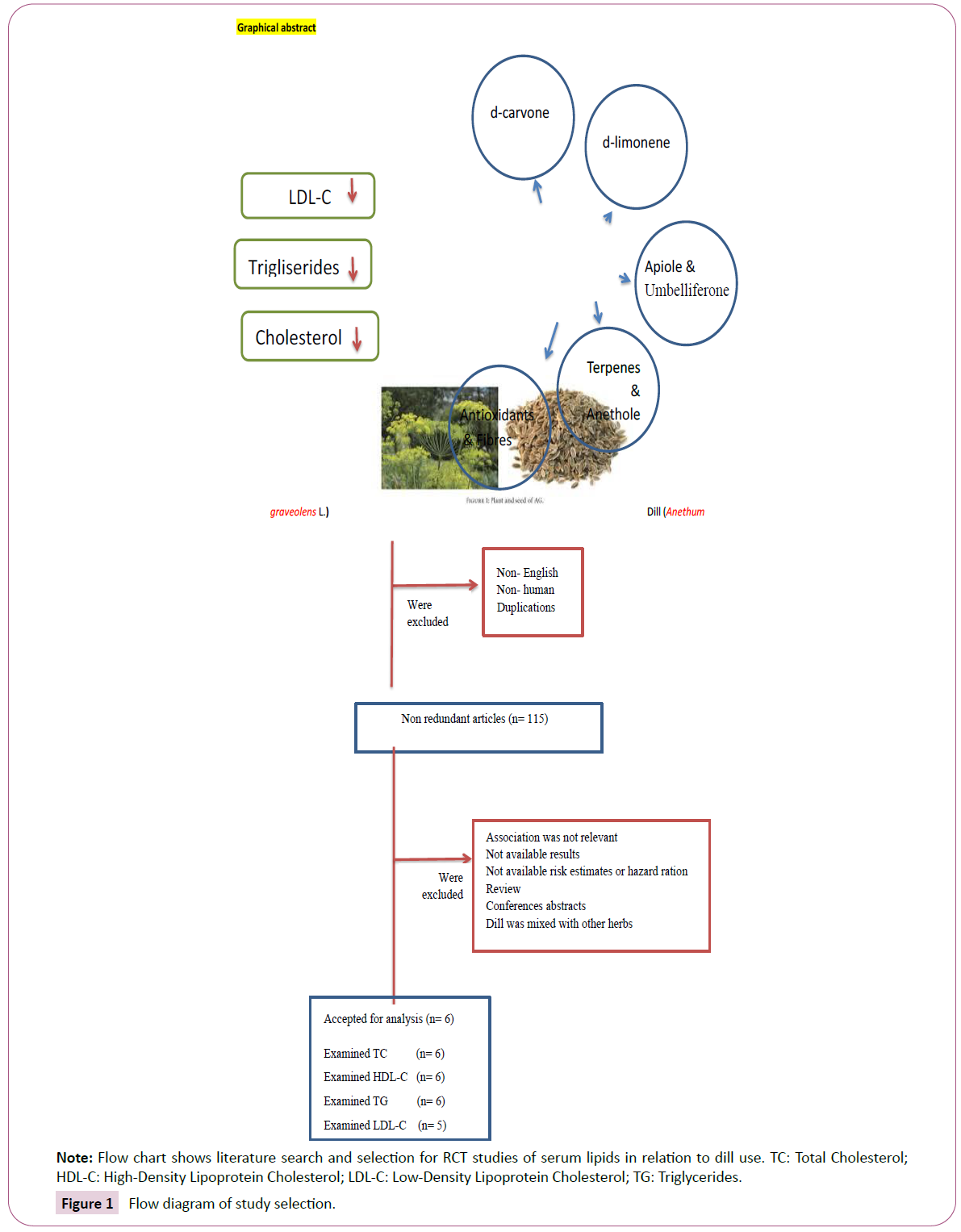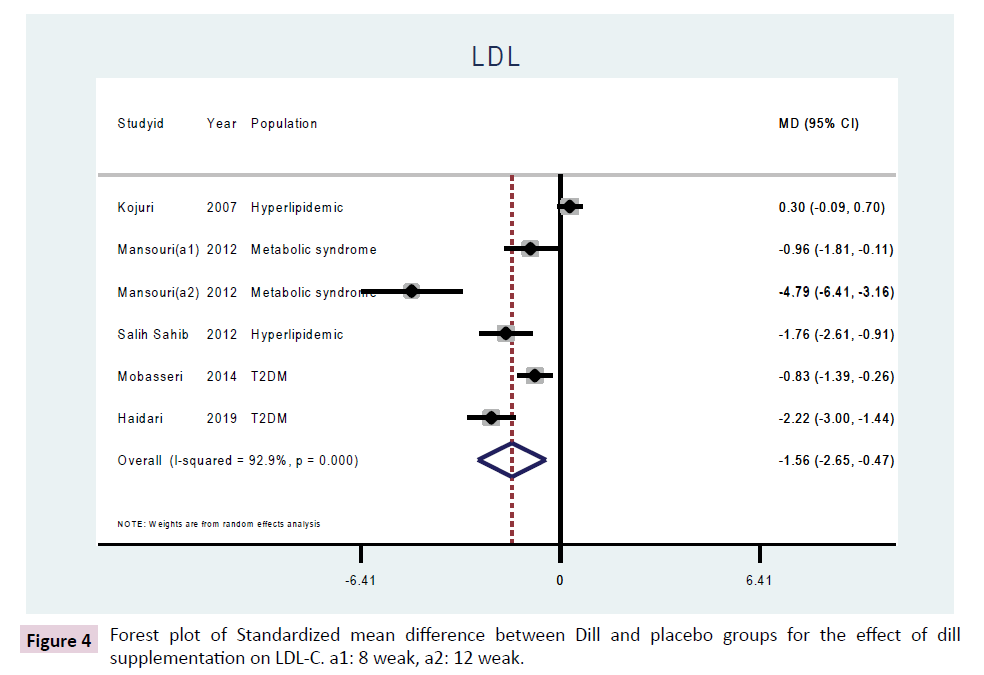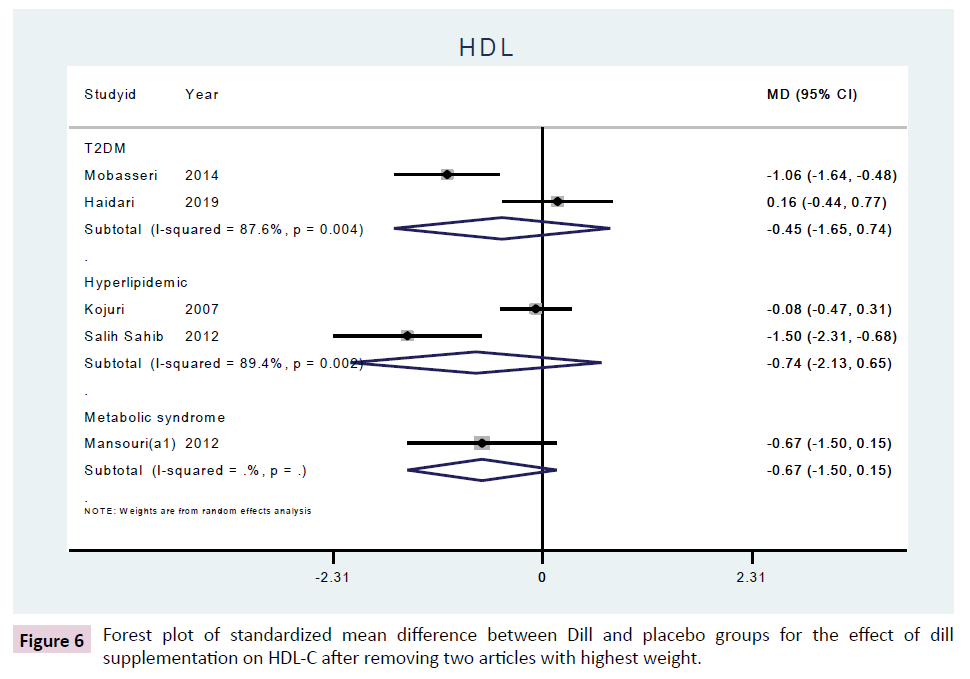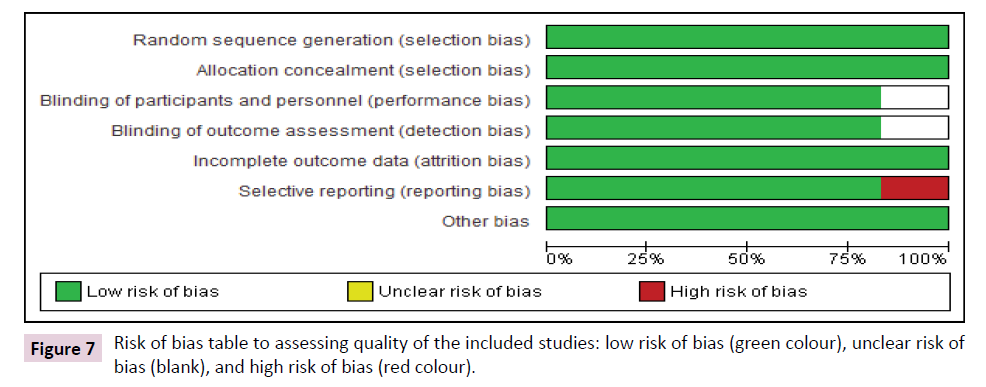ISSN : 2321-2748
American Journal of Phytomedicine and Clinical Therapeutics
Effect of Anethum graveolens L. (Dill)Consumption on Serum Lipids: A Systematic Review and Meta-analysis
1Cardiac Rehabilitation Research Center, Cardiovascular Research Institute, Isfahan University of Medical Sciences, Isfahan, Iran
2Anesthesiology Department, International Cardiology Research Center, Cardiovascular Research Institute, Isfahan University of Medical Sciences, Isfahan, Iran
- *Corresponding Author:
- Masoumeh Sadeghi
Cardiac Rehabilitation Research Center
Cardiovascular Research Institute
Isfahan University of Medical Sciences, Isfahan, Iran
Tel: +00989120259289
E-mail: sadeghimasoumeh@gmail.com
Received Date: September 09, 2020; Accepted Date: March 03, 2021; Published Date: March 10, 2021
Citation: Sadeghi M, Kabiri S, Amerizadeh A, Heshmat-Ghahdarijani K, Masoumi G, et al. (2021) Effect of Anethum graveolens L. (Dill) Consumption on Serum Lipids: A Systematic Review and Meta-analysis. Am J Phytomed Clin Ther Vol.9 No.3:9.
Abstract
Background: Anethum graveolens L. (dill) has been used as traditional medicinal plant for abdominal discomfort, colic, sleep disprders and for promoting digestion since ancient times. Recently, lipid-lowering effect of dill has been noticed.
Aim of the study: We conducted a meta-analysis to evaluate the effect of dill supplementation on human serum lipid profile.
Methods: A systematic search for English published randomized controlled trials (RCTs) was performed up to December 2019 covering PubMed, EMBASE, Scopus and Coherence library. Inclusion criteria were RCT study design, at least one of lipid profile components (triglyceride, total cholesterol, LDL-C and HDL-C) levels measured before dill use and also reported as result. The pooled weighted mean difference (MD) and its 95% confidence interval (CI) were calculated and pooled using a random-effects model.
Results: Pooled data of six RCTs involving 171 intervention cases indicated that dill supplementation was associated with a significant reduction in mean serum total cholesterol (MD 95% CI=-3.71 (-5.71,-1.70); p < 0.001), low-density lipoprotein cholesterol (LDL-C) (MD 95% CI=-1.51 (-2.65,-0.47); p=0.005), triglycerides (MD 95% CI=-2.48 (-3.98,-0.98); p=0.001) and interestingly high-density lipoprotein cholesterol level (HDL-C) (MD 95% CI=-2.19 (-3.58,-0.81); p=0.002). Subgroup analysis showed that dill use was more effective in lowering triglyceride in both hyperlipidemic patients, MD 95% CI=-3.54 (-6.49,-0.60); p=0.02) and type 2 diabetes (MD 95% CI=-3.64 (-5.69,-1.58); p=0.001). Dill use reduced the LDL levels more effectively in patients with type 2 diabetes (MD 95% CI=-3.54 (-6.49,-0.60); p=0.03).
Conclusion: Dill supplementation significantly improved LDL-C, TG and TC levels but not HDL-C. Further high quality controlled clinical trials on human is needed for more accurate and confirm conclusion.
Keywords
Meta-analysis; Anethum graveolens; Dill; Lipids
Introduction
It is estimated that hyperlipidemia/dyslipidemia is responsible for more than 4 million deaths annually (WHO, 2019). High levels of triglycerides (TG), total cholesterol (TC), and low density lipoprotein-cholesterol (LDL-C) are considered as the main cause of cardiovascular disease (CVD) and atherosclerosis [1]. Fortunately high cholesterol level (LDL-C) is significantly reduced by chemical drugs such as statins through competitive inhibition of 3-hydroxy-3-methylglutaryl-coenzyme A (HMG-CoA) reductase which is the rate-limiting enzyme in the biosynthesis pathway of cholesterol. This enzyme causes significant reduction in LDL-C production by the liver and clearance of LDL-C from blood circulation [2]. Despite the high effect of statins that can reduce hearth disease significantly these drugs showed many side effects such as headache, difficulty sleeping, dizziness, drowsiness and abdominal cramping [3]. Even a small pickup in statin geriatric special side effects would compensate the cardiovascular benefit [4]. Therefore natural medicinal herbs could be effective, available and cheaper lipid lowering agents compared to their synthetic counterparts. Many traditional herbal medicine are using now-a-days as food-based supplementary treatment such as sumac, fenugreek, beetroot, and many others [5]. Anethum graveolens L. known as dill is the sole species of the genus Anethum in the celery family (Apiaceae or Umbelliferae) containing mostly aromatic flowering plants [6]. Dill has been used for a long time as a spice for seasoning and flavoring of various foods such as rice, sauces, salads, side dishes and soups in different countries [7]. The seed oil and aqueous extracts of this plant has antimicrobial and antifungal activity against different bacteria such as E. coli, S. aureus, Shigella flexneri, P. aeruginosa, S. typhimurium and Salmonella typhii [8]. Dill has been used from long time ago in ayurvedic medicines for rheumatic and other swellings of joints, abdominal discomfort and digestion problems . Recently dill showed hypoglycemic and cholesterol lowering properties [9]. In Iran it is used as Anethum tablets (AG (68%), Citrus aurantifolia (4%), Cichorium intybus (5%), and Fumaria parviflora (5%)) by prescription to reduce glucose or lipid levels. Many studies proved the anti-hypercholesterolemic /anti-hyperlipidemic activity for this herb [10]. However the results are not consistent [11] so they need to be synthesized and put into perspective. Also the use of this medicinal plant is not as common as other herbs to reduce blood lipids worldwide. To our knowledge no meta-analysis study was performed so far to investigate the effect of Anethum graveolens L. (dill) on lipid profile in human and this study is the first.
Materials and Methods
Literature search
Relevant studies were identified by searching PubMed, Scopus, Coherence library and EMBASE up to December 2019. We included studies estimating the relative risk (RR) with 95% confidence intervals (CIs) for the associations of specific lipid components including (total cholesterol [TC], high-density lipoprotein cholesterol [HDL-C], low-density lipoprotein cholesterol [LDL-C], and triglycerides [TG]) with use of Anethum graveolens L. (dill). The following terms were used: “cholesterol,” “triglyceride,” “high-density lipoprotein [HDL-C],” low-density lipoprotein [LDL-C], “dill,” “Anethum graveolens L.” Then duplicating and overlapping articles excluded, also full texts of relevant papers were read. The search was refined to the English language and human subjects. The search, data extraction, and quality assessment were completed independently by 2 reviewers (SK & AA). Any discrepancies between the 2 reviewers were resolved through a discussion until a consensus was reached.
Study selection
Eligible studies for this meta-analysis were fulfilled the following criteria: 1) the study design was a RCT study, 2) the exposure of interest was serum concentration of at least one of the selected lipid components (TC, HDL-C, LDL-C, TG) measured prior to use of dill, 3) the outcome of interest was one of the lipid components level, and 4) the relative risk (RR) with corresponding 95% confidence interval (CI, or data to calculate them) were reported. If data were duplicated in more than one study, we included the study with the largest number of cases. Flow chart of the study selection is shown in Figure 1.
Quality assessment
The risk of bias in included trials was assessed using the Cochrane Collaboration’s tool for assessing risk of bias. Each RCT was given one of three rankings, ‘high risk’, ‘low risk’, or ‘unclear risk’, in each of the following domains: sequence, generation, allocation concealment, blinding of participants, personnel and outcome assessors, incomplete outcome data, selective outcome reporting and other sources of bias.
Data extraction
The search, data extraction, and quality assessment were completed independently by 2 reviewers (SK & AA). Any discrepancies between the 2 reviewers were resolved through a discussion until a consensus was reached. The following data were recorded: first author’s surname, publication year, population, health status, follow-up periods, age and numbers of cases and participants, ranges of serum lipid levels, RRs from the most fully adjusted model for the highest versus lowest category of serum lipids and the corresponding 95% CIs, and matching or adjustments for confounding factors.
Statistics methods
The mean difference and 95% confidence interval (CI) was calculated for each outcome in both groups (dill and placebo) to estimate changes in two groups (intervention (dill) versus placebo). Significance of the difference for the mean of intervention and placebo groups was checked by Z-test. The heterogeneity between RCTs was checked by I2 statistic and Chisquare test. Random-effect model was used if the high degree of heterogeneity was indicated (I2 > 50%, and P-values <0.1 for the chi-square test) Subgroup analysis and Meta regression were used to investigate the source of heterogeneity according some effective factors. The publication bias was investigated by tests methods [12]. All the results conducted by Stata-14.
Results
All 6 studies had control group invloving 121 control cases and 171 in test group had plasebo group and examined the effect of dill on cholesterol, triglycerides, and HDL-C [13]. One of the staudies had two set of results in two different follow-up time [14]. Five studies examined the effect of dill consumption on LDL-C [15]. Two studies were performed on type 2 diabetics, three studies on hyperlipidemia and one study on metabolic syndrome. In total, 159 patients were in the intervention group and 166 in the control group. Five studies were performed in Iran [16] and one in Iraq [17]. The basic characteristics of all included studies summarized in Table 1.
| Study ID | country | year | mb | sb | ma | sa | mb | sb | ma | sa | n1 | n2 | Type of consumption |
Follow-up duration | Statues |
|---|---|---|---|---|---|---|---|---|---|---|---|---|---|---|---|
| Mobasseri | Iran | 2014 | 87.07 | 20.19 | 71.57 | 23.08 | 91.23 | 21.1 | 84.65 | 6.12 | 26 | 26 | Dill Powder | 8 weeks | T2DM |
| Haidari | Iran | 81 | 34.79 | 71.23 | 26.63 | 71.71 | 23.55 | 74.8 | 22.8 | 21 | 21 | Dill Powder | 8 weeks | T2DM | |
| Kojuri | Iran | 2007 | 9.34 | 51.96 | -2.3 | 14.71 | 50 | 50 | Dill Tablet | 6 weeks | Hyperlipidemic | ||||
| Mansouri | Iran | 2012 | 116.9 | 17.3 | 109.2 | 16.1 | 122.1 | 18.5 | 124.4 | 15.8 | 12 | 12 | Dill Extract | 12 weeks | Metabolic Syndrome |
| Mansouri | Iran | 2012 | 116.9 | 17.3 | 113.1 | 14.7 | 122.1 | 18.5 | 122.5 | 12.9 | 12 | 12 | Dill Extract | 8 weeks | Metabolic Syndrome |
| Mirhosseini | Iran | 2014 | 35 | Dill Tablet | 8 weeks | Hyperlipidemic | |||||||||
| Salih Sahib | Iraq | 2012 | 15 | Dill Powder Capsules | 4 weeks | Hyperlipidemic |
Table 1: Characteristics of studies on serum lipids and dill consumption in this meta-analysis.
The combination of the results of these studies showed that the dill consumption had a significant effect on the reduction of TC (MD 95% CI=-3.71 (-5.71,-1.70); p < 0.001) (Figure 2), TG (MD 95% CI=-2.48 (-3.98,-0.98); p=0.001) (Figure 3), LDL-C (MD 95% CI=-1.51 (-2.65,-0.47); p=0.005) (Figure 4) and also HDL-C (MD 95% CI=-2.19 (-3.58,-0.81); p=0.002) (Figure 5). Egger's test result for the publication bias was not significant for both HDL (p=0.095) and triglyceride (p=0.209). But the result of this test was significant for both cholesterol (p=0.041) and LDL-C (p=0.022). The Trim and Fill methods were used to modify the results, although the results did not change. Since the results showed that HDL-C was reduced, sensitivity analyses was performed for HDL-C however the results after removing two articles with highest weight [18] still showed hat the HDL-C level was decreased (Figure 6).
Subgroup analysis
The results of subgroup analysis based on the type of disease showed that dill consumption had the greatest effect on cholesterol in hyperlipidemic patients, which significantly reduced in these patients (MD 95% CI=-16.01 (-26.57,-5.44); p=0.003). Dill use was more effective in lowering triglyceride in both hyperlipidemic patients, MD 95% CI=-3.54 (-6.49,-0.60); p=0.02), and also in type 2 diabetes (MD 95% CI=-3.64 (-5.69,- 1.58); p=0.001). Dill use reduced the LDL-C levels only for patients with type 2 diabetes (MD 95% CI=-3.54 (-6.49,-0.60); p=0.03). But about HDL-C there was no difference between the subgroups.
Quality assessment
To assess the quality of the included studies, we used the risk of bias table. In this table, the bias of each study, in particular, the design-related bias was evaluated. Out of 6 studies, only 1 studies had reporting bias. In general, all studies were out of bias (high quality). This table was designed according to Review Manager 5.3 (Figure 7).
Discussion
So far no meta-analysis had been conducted to evaluate the hypolipidemic effect of A. graveolens L. (dill) on lipid profile in human population. Some studies showed that dill can reduce cholesterol [18] or triglyceride [19] effectively while the others are not agreeing [20]. Therefore this meta-analysis was performed to evaluate the effect of dill consumption on lipid profile in human serum. In our meta-analysis six RCTs were included after searching PubMed, Scopus, EMBASE and Coherence library [21]. Surprisingly five of these six studies were performed in Iran [22]. This might be due to the fact that dill is used widely as anti-hyperlipidemic food-based treatment in Iranian folk medicine [23]. In Iran, dill is called as ‘Shevid’ and is used mostly in foods such as rice known as ‘Shevid polo’ and special soup called ‘aash’. It is used also in yoghurt and salad and many other side dishes in Iran. A. graveolens L. or European dill is one of the two dill species under cultivation which growing mostly in the Europe Mediterranean region, central and southern part of Asia [24]. The growing condition in south-eastern of Iran (where dill is cultivated mostly) is favourable and adequate for this plant since it prefers full sun and pH range of 5.3 to 7.8. Each part of this plant including root, seed and leaves were rich in tannins, cardiac glycosides, terpenoids and flavonoids. The main constituents of dill are d-carvone (C10H14) [25]. d-limonene (C10H16), α- phellandrene (C10H16), β-phellandrene (C10H16) Myristicin (C11H12O3) (Apiole (C12H14O4) Umbelliferone (C9H6O3) Anethole (C10H12O) and P- anisaldehyde (C8H8O2) (Terpenes were the most abundant volatiles identified in dill.
The result of different animal studies indicated that dill when used as diet for animals both as powder and extract, reduces the TC, TG and LDL-C levels According to the results of this metaanalysis one study on hyperlipidemic patients showed that dill had no significant effect on lipid profile components. Another study on diabetic patients showed that dill had significant effect on some lipid profile components such as TC and LDL-C but not on HDL-C and TG. Heidari et al. showed that TC, LDL-C and TG decreased and HDL-C increased significantly in the intervention group after dill powder consumption in diabetic patients. Sahib et al. in a study on hyperlipidemic patients showed that TC, TG and LDL-C reduced significantly in dill group however based on their results the HDL level also decreased in these patients.
In our meta-analysis the TC, TG and LDL-C levels decreased significantly but interestingly the HDL level also showed to be decreased. This might be because of the studies by that both showed HDL level is reduced in dill group by 0.8% and 8.5% respectively. According to article by Sahib et al. the significant TG reduction in dill group after 4 weeks was higher compared to standard hypolipidemic agent such as lovastatin, 19.9% vs. 12.7% which is in contrast to the findings reported by Mobasseri.
The exact underlying anti-hyperlipidemic mechanism of dill is not completely elucidated. One of the main mechanisms by which dill may lower blood lipid levels could be due to the d-limonene existence in dill as one of the major constituent, which proved to have an important role in cholesterol reduction. D-limonene is a great solvent of cholesterol; therefore it has been used clinically to dissolve cholesterol-containing gallstones. D-limonene is a major component in several citrus oils (orange, lemon, lime, mandarin and grapefruit) additionally, antioxidants components including polyphenols, vitamin C and carotenoieds found in abundance in dill which may significantly contribute to dill’s activity in lowering blood lipid. Two flavonoids have been isolated from dill seed; quercetin and isoharmentin which have antioxidant activity. Antioxidants help to prevent oxidative damage and fight against free radicals. Free radicals may contribute to endothelial dysfunction which leads to increasing the susceptibility to atherosclerosis, hypertension, and hypercholesterolemia. Free radicals can also increase the oxidative burden of low-densitylipoprotein (LDL) and may accelerate the atherosclerotic process One of the other plausible reasons for hypolipidemic activity of dill may refer to decreased absorption of cholesterol by binding to bile acids, inhibition of fatty acid and cholesterol synthesis through suppression of acetyl-CoA carboxylase and HMG-COA reductase activity, and stimulating cholesterol clearance by increasing LDL receptors Considering the low number of articles on this topic future research with larger sample sizes and higher quality is warranted to extend our findings and firmly establish the clinical efficacy of the plant as lipid-lowering agent.
Conclusion
In conclusion the present meta-analysis indicated that Anethum graveolens L. (dill) had beneficial effect on TC, TG and LDL-C levels. However dill treatment did not show positive effect on HDL. Subgroup analysis based on the type of the disease showed that the dill was more effective in lowering TC in hyperlipidemic patients, triglyceride in both hyperlipidemic and type 2 diabetic patients and LDL-C in type 2 diabetic patients. Due to the limited number of articles in this study, larger studies might be needed to prove the safety and efficacy of long-term administration of dill to treat dyslipidemia.
Limitations
Only language restriction was considered in our study (only English published articles were considered). Risk of bias for all lipid components in this meta-analysis was not significant. The full text of eligible articles could be found via different data bases and there was no contact with authors to find full-text articles.
References
- Agte VV, Tarwadi KV, Mengale S, Chiplonkar SA (2000) Potential of traditionally cooked green leafy vegetables as natural sources for supplementation of eight micronutrients in vegetarian diets. J Food Comp Anal 13: 885-891.
- Amarenco P, Labreuche J (2009) lipid management in the prevention of stroke: review and updated meta-analysis of statins for stroke prevention. Lancet Neurol 8: 453–463.
- Arora DS, Kaur JG (2007) Antibacterial activity of some Indian medicinal plants. J Nat Med 61: 313–317.
- Asgary S, Afshani MR, Sahebkar A, Keshvari M, Taheri M, et al. (2016) Improvement of hypertension, endothelial function and systemic inflammation following short-term supplementation with red beet (Beta vulgaris L.) juice: A randomized crossover pilot study. J Hum Hypertens 30: 627-632.
- Bailer J, Aichinger T, Hackl G, Hueber KD, Dachler M (2001) Essential oil content and composition in commercially available dill cultivars in comparison to caraway. Indus Crops Prods 14: 229–239.
- Begg CB, Mazumdar M (1994) Operating characteristics of a rank correlation test for publication bias. Biometrics. 50: 1088-1101.
- Blank I, Grosch W (1991) Evaluation of potent odorants in dill seed and dill herb (Anethum graveolens L.) by aroma extract dilution analysis. J Food Sci 56: 63–67.
- Blank I, Sen A, Grosch W (1992) Sensory study on the character-impact flavour compounds of dill herb (Anethum graveolens L. Food Chem. 43: 337–343.
- Brugts JJ, Deckers JW (2010) Statin prescription in men and women at cardiovascular risk: To whom and when? Curr Opin Cardiol 25: 484–489.
- Brugts JJ, Yetgin T, Hoeks SE, Gotto AM, Shepherd J, et al. (2009) The benefits of statins in people without established cardiovascular disease but with cardiovascular risk factors: A meta-analysis of randomised controlled trials. BMJ Case Reports 330: 338.
- Chaurasia SC, Jain PC (1978) Antibacterial activity of essential oils of four medicinal plants. Indian J Hosp Pharm 15 166–168.
- Delaquis PJ, Stanich K, Girard B, Mazza G (2002) Antimicrobial activity of individual and mixed fractions of dill, cilantro, coriander and eucalyptus essential oils. Int J Food Microbiol 74: 101-109.
- Der Simonian R, Laird N (1986) Meta-analysis in clinical trials. Controlled Clinical Trials 7: 177-188.
- Dhalwal K, Shinde VM, Mahadik KR (2008) Efficient and sensitive method for quantitative determination and validation of Umbelliferone, carvone and Myristicin in Anethum graveolens and Carum carvi seeds. Chromatograph 67: 163–167.
- Egger M, Davey Smith G, Schneider M, Minder C (1997) Bias in meta-analysis detected by a simple, graphical test. BMJ. 315: 629-634.
- Forstermann U, Munzel T (2006) Endothelial nitric oxide synthase in vascular disease. Circulation 113: 1708–1714.
- Glatthaar BE, Hornig DH, Moser U (1986) The role of ascorbic acid in carcinogenesis. Adv Exp Med Biol 206: 357-377.
- Godo S, Shimokawa H (2017) Endothelial Functions. Arter Thromb Vasc Biol 37: e108–e114.
- Goldstein JL, Brown MS (2009) The LDL receptor. Arter Thromb Vasc Biol 29: 431-438.
- Goodarzi MT, Khodadadi I, Tavilani H, Oshaghi EA (2016) The role of Anethum graveolens L. (Dill) in the management of diabetes. J Trop Med 1098916.
- Haghighi B, Kharazizadeh M, Attar M (2010) Possible involvement of hepatic phosphatidate phosphohydrolase in the mechanisms of actions of certain antilipemic drugs in rats. Iran J Pharm Res 6: 273-278.
- Amoochi G, Haidari F, Zakerkish M, Borazjani F, Angali KA (2001) The effects of Anethum graveolens (dill) powder supplementation on glycemic control, lipid profile, some antioxidants and inflammatory markers, and gastrointestinal symptoms in type 2 diabetic patients: A double-blind, placebo-controlled trial 2: 1.
- Hajhashemi V, Abbasi N (2008) Hypolipidemic activity of Anethum graveolens in rats. Phytotherapy Res 22: 372-375.
- Higgins JP, Thompson SG, Deeks JJ, Altman DG (2003) Measuring inconsistency in meta-analyses. BMJ Case Reports 32: 557-560.
- Heshmat-Ghahdarijani K, Mashayekhiasl N, Amerizadeh A, Teimouri-jervekani Z, Sadeghi M (2020) Effect of fenugreek consumption on serum lipid profile: A systematic review and meta-analysis. Phytotherapy Research p. 1- 16.

Open Access Journals
- Aquaculture & Veterinary Science
- Chemistry & Chemical Sciences
- Clinical Sciences
- Engineering
- General Science
- Genetics & Molecular Biology
- Health Care & Nursing
- Immunology & Microbiology
- Materials Science
- Mathematics & Physics
- Medical Sciences
- Neurology & Psychiatry
- Oncology & Cancer Science
- Pharmaceutical Sciences







